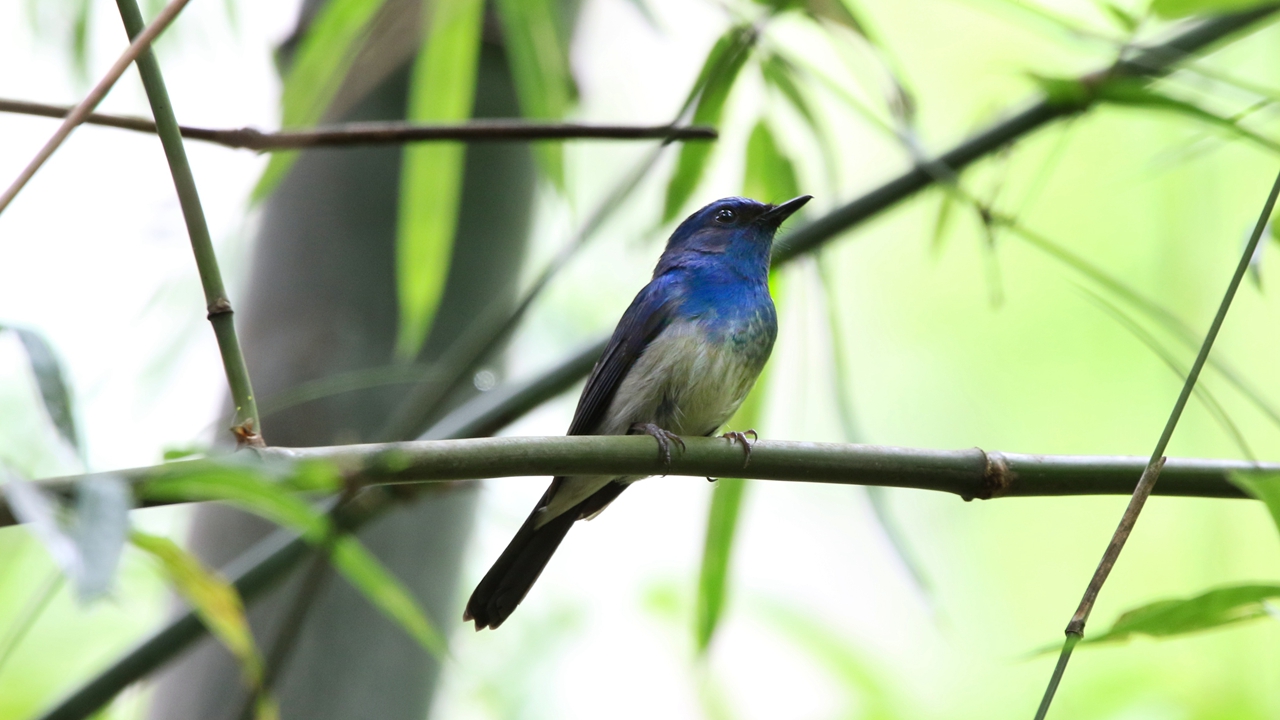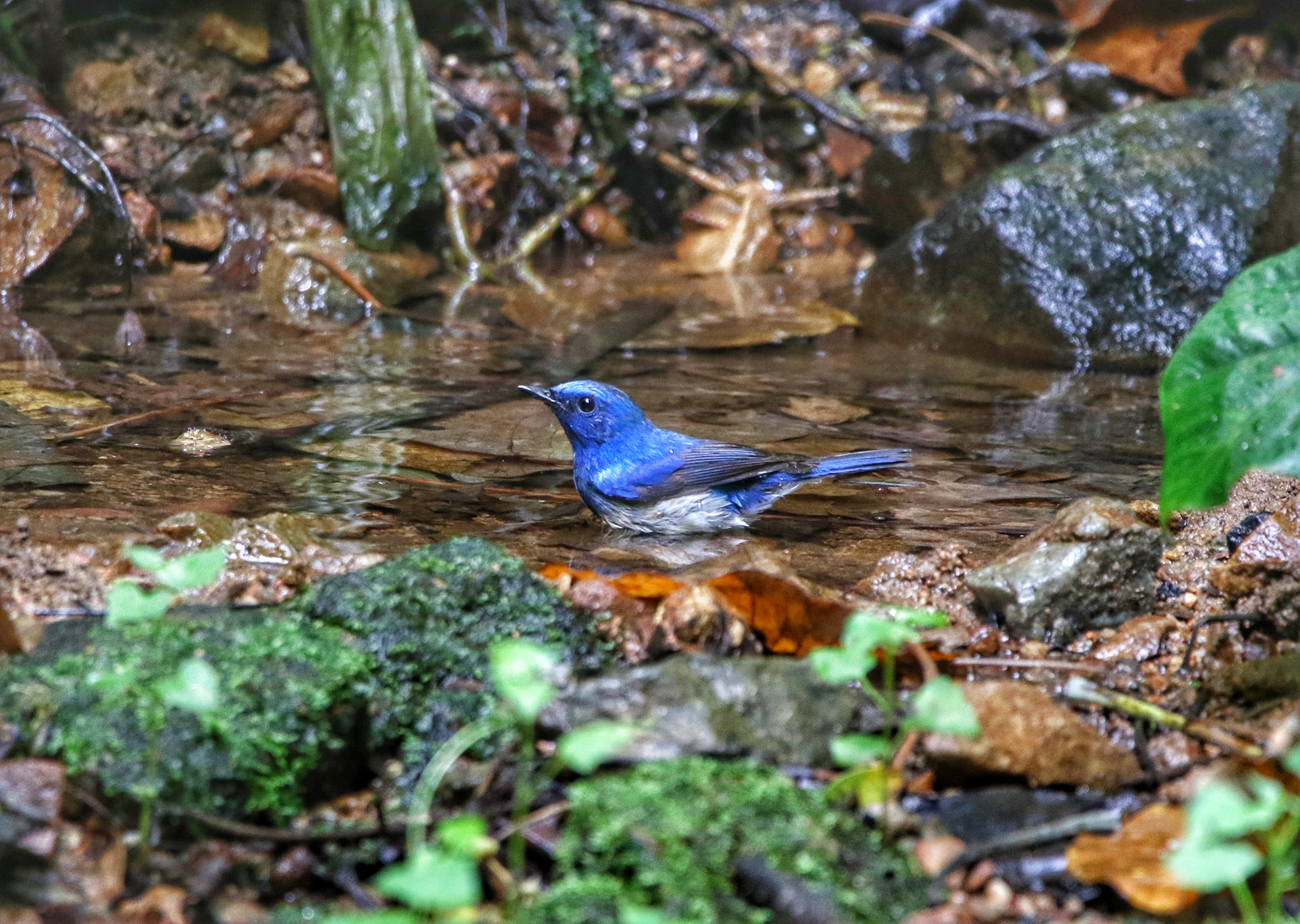The Hainan blue flycatcher
Writer: Isaac Cohen | Editor: Zhang Chanwen | From: Original

A Hainan blue flycatcher is perched on a branch in Bijia Hill Park in Futian District. Photos by Isaac Cohen
The Hainan blue flycatcher
The Hainan blue flycatcher (Cyornishainanus) is a medium-sized bird, measuring around 15 centimeters long. Males don a vibrant blue plumage on the upperparts and pale white or yellow feathers on the underparts, sporting a distinct black eye mask and throat patch. Females exhibit a more subdued appearance with mostly a duller olive brown color and less prominent markings.
海南蓝仙鹟(Cyornishainanus) 是一种中体型的鸟类,身长约15厘米。雄性海南蓝仙鹟上半身羽毛呈艳蓝色,下半身羽毛呈淡白色或黄色,眼睛周围和喉咙处都有一片显眼的黑色。雌性海南蓝仙鹟的外貌则相对低调,羽毛多呈橄榄棕色,身上的斑点也不太显眼。
Thriving in Shenzhen’s lush forests and woodlands, the bird seeks out dense vegetation and can often be found near streams, rivers, and other water sources. These habitats provide an abundance of insects and small invertebrates that these birds feed on.
这种鸟类寻植被茂密处栖身,在深圳的茂密森林或林地蓬勃生长,人们可以在小河、溪流和其他水源地附近看见它们。这些栖息地有许多昆虫和无脊椎小动物,可供海南蓝仙鹟捕食。

A Hainan blue flycatcher is perched on a branch in Bijia Hill Park in Futian District.
The Hainan blue flycatcher is a non-migratory species that establishes its perennial territory within its preferred habitats. Members of the species observed in Shenzhen have apparently come from the northern parts of Guangdong and decided to stay.
海南蓝仙鹟没有迁徙的习性,它们会在喜欢的栖息地建立长期的领地。在深圳发现的这一群海南蓝仙鹟,看起来是从广东省北部飞来,然后决定在此地定居。
Displaying adept aerial hunting skills, these birds gracefully swoop from perches, capturing their prey mid-air. Preying on a variety of insects, such as flies, beetles, caterpillars, and spiders, the flycatchers help control insect populations and contribute to the natural balance within its ecosystem.
这种鸟儿具有很强的空中捕食能力,它们从栖枝上优雅俯冲而下,在半空中将猎物捕获。海南蓝仙鹟以飞虫、甲虫、毛虫、蜘蛛等昆虫为食,有助于控制昆虫的数量,维护它们所处生态系统的自然平衡。
During their breeding season between March and June, the females lay clutches of up to four eggs, which both parents diligently incubate for about two weeks. They also share the responsibilities of caring and feeding the hatchlings. The chicks fledge, and the population within the family quickly proliferates after a couple of weeks. The young will achieve independence shortly after.
每年三月到六月是海南蓝仙鹟的繁殖期。雌鸟大致产4颗卵,雄鸟和雌鸟都会辛勤地孵育这些卵约两周,它们也会共同承担照料和喂养雏鸟的责任。随着雏鸟羽翼丰满,海南蓝仙鹟家庭在几周内人口激增。再过一小段时间,雏鸟就要独立生活了。
The mesmerizing beauty and captivating behaviors of this species often attract birdwatchers and nature enthusiasts. Their melodious songs and vibrant plumage make them a delightful scene, promoting the appreciation and conservation of the natural habitats that support their existence.
海南蓝仙鹟的迷人美貌和有趣行为常常吸引观鸟者和自然爱好者围观。它们歌声动听、羽毛鲜艳,成为了一道亮丽的风景,这也促进了人们去保护它们赖以生存的自然栖息地。(Xu Zixuan)